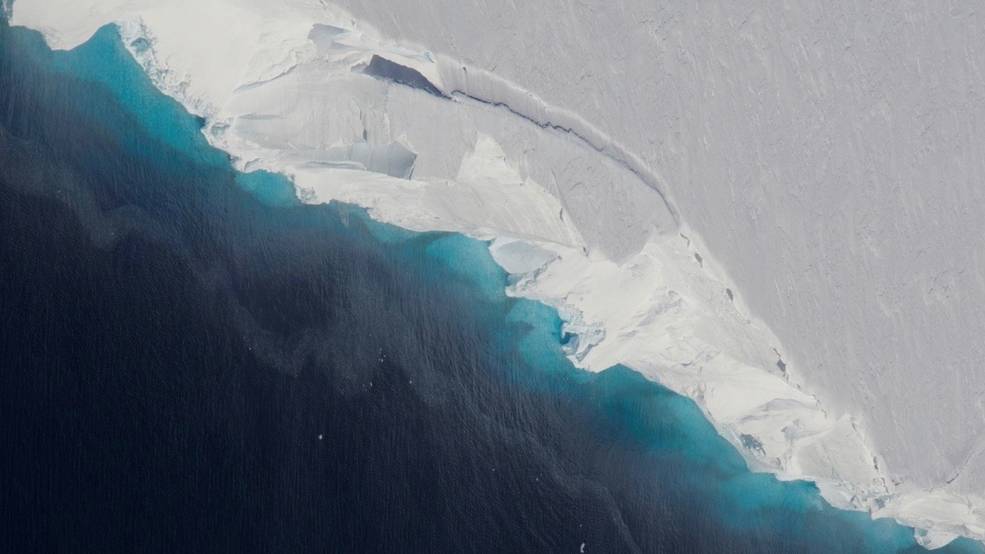A gigantic cavity — two-thirds the area of Manhattan and almost 1,000 feet (300 meters) tall — growing at the bottom of Thwaites Glacier in West Antarctica is one of several disturbing discoveries reported in a new NASA-led study of the disintegrating glacier. The findings highlight the need for detailed observations of Antarctic glaciers’ undersides in calculating how fast global sea levels will rise in response to climate change.
Researchers expected to find some gaps between ice and bedrock at Thwaites’ bottom where ocean water could flow in and melt the glacier from below. The size and explosive growth rate of the newfound hole, however, surprised them. It’s big enough to have contained 14 billion tons of ice, and most of that ice melted over the last three years.
«We have suspected for years that Thwaites was not tightly attached to the bedrock beneath it,» said Eric Rignot of the University of California, Irvine, and NASA’s Jet Propulsion Laboratory in Pasadena, California. Rignot is a co-author of the new study, which was published today in Science Advances. «Thanks to a new generation of satellites, we can finally see the detail,» he said.
The cavity was revealed by ice-penetrating radar in NASA’s Operation IceBridge, an airborne campaign beginning in 2010 that studies connections between the polar regions and the global climate. The researchers also used data from a constellation of Italian and Germanspaceborne synthetic aperture radars. These very high-resolution data can be processed by a technique called radar interferometry to reveal how the ground surface below has moved between images.
«[The size of] a cavity under a glacier plays an important role in melting,» said the study’s lead author, Pietro Milillo of JPL. «As more heat and water get under the glacier, it melts faster.»
nasa.gov

Una gigantesca cavidad (dos tercios del área de Manhattan y casi 1.000 pies (300 metros) de altura) que crece en el fondo del glaciar Thwaites en la Antártida occidental es uno de los varios descubrimientos perturbadores reportados en un nuevo estudio dirigido por la NASA sobre el glaciar desintegrado. Los hallazgos resaltan la necesidad de observaciones detalladas de la parte inferior de los glaciares antárticos para calcular qué tan rápido se elevarán los niveles globales del mar en respuesta al cambio climático.
Los investigadores esperaban encontrar algunas brechas entre el hielo y la roca de fondo en el fondo de Thwaites donde el agua del océano podría fluir y derretir el glaciar desde abajo. El tamaño y la tasa de crecimiento explosivo del nuevo agujero, sin embargo, los sorprendió. Es lo suficientemente grande como para contener 14 mil millones de toneladas de hielo, y la mayor parte de ese hielo se derritió en los últimos tres años.
«Durante años hemos sospechado que Thwaites no estaba bien atado a la roca subyacente», dijo Eric Rignot, de la Universidad de California, Irvine, y del Laboratorio de Propulsión a Chorro de la NASA en Pasadena, California. Rignot es coautor del nuevo estudio, que se publicó hoy en Science Advances. «Gracias a una nueva generación de satélites, finalmente podemos ver los detalles», dijo.
La cavidad fue revelada por un radar de penetración de hielo en la Operación IceBridge de la NASA, una campaña aerotransportada que comenzó en 2010 y estudia las conexiones entre las regiones polares y el clima global. Los investigadores también utilizaron datos de una constelación de radares de apertura sintética de vehículos espaciales italianos y alemanes. Estos datos de muy alta resolución se pueden procesar mediante una técnica llamada interferometría de radar para revelar cómo la superficie del suelo debajo se ha movido entre las imágenes.
«[El tamaño de] una cavidad bajo un glaciar juega un papel importante en la fusión», dijo el autor principal del estudio, Pietro Milillo, de JPL. «A medida que más calor y agua penetran en el glaciar, se derrite más rápido».


